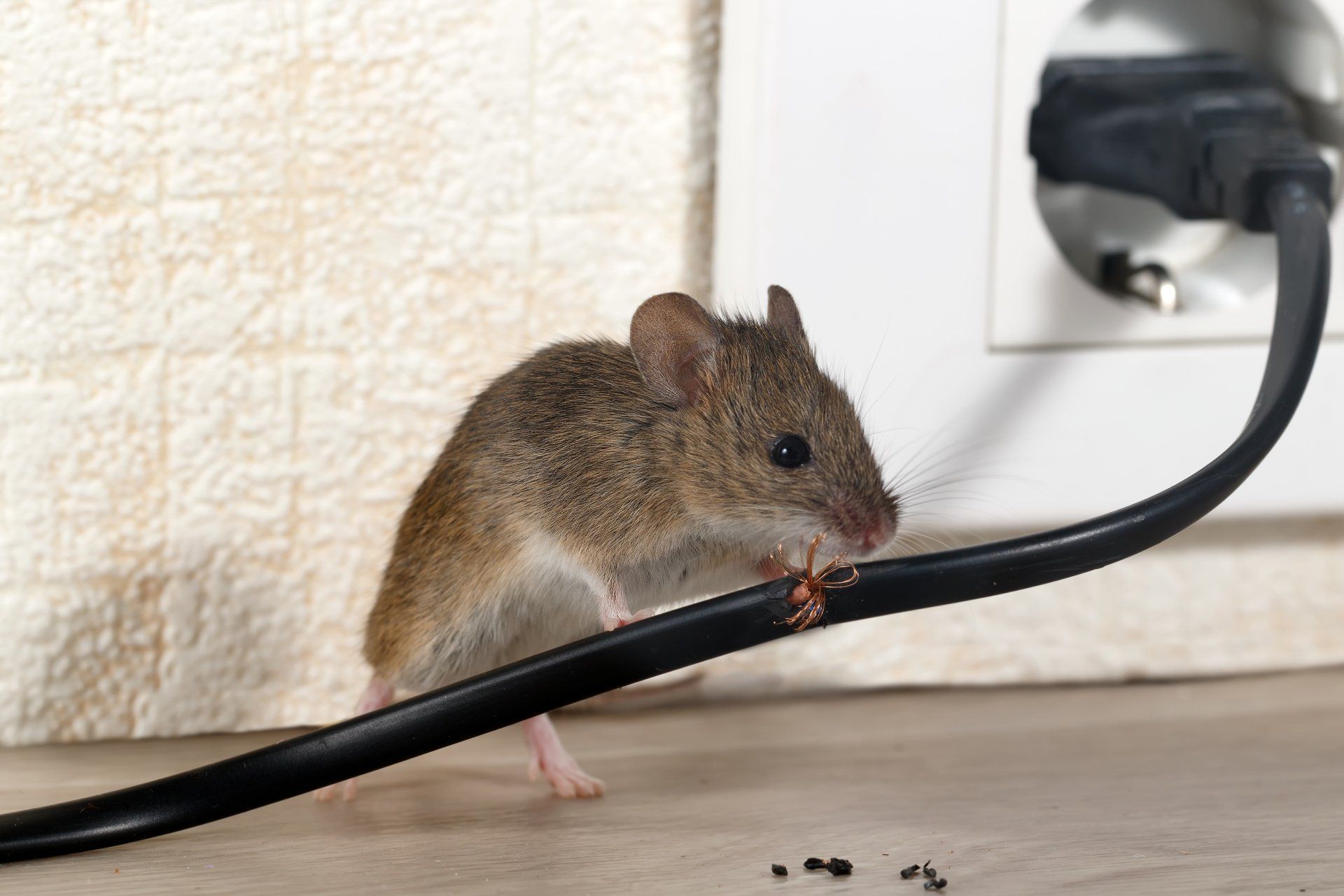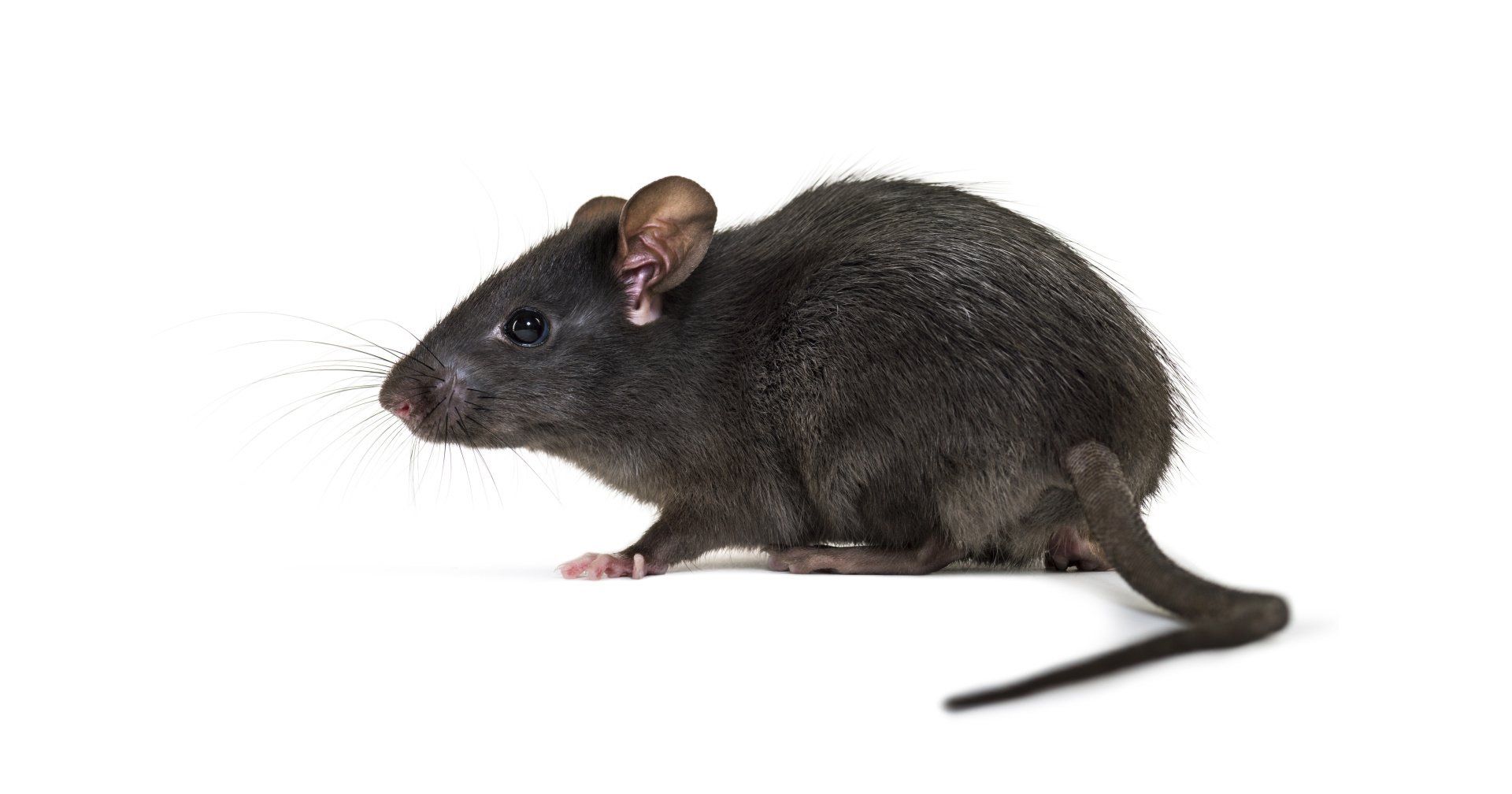Rat vs Mouse
What is the Difference Between Rat and a Mouse?

| Feature | Roof Rat | Norway Rat | House Mouse |
|---|---|---|---|
| Length | ~8 inches | ~9.5 inches | 2 - 4 inches |
| Tail length | 6 - 8 inches | ~6.5 inches | 2 - 4 inches |
| Litter Count | 5 - 10 | 7 - 8 | 4 - 16 |
| Litter Annual | 3 - 6 | 3 - 6 | 7 - 8 |
| Ears | Small and flat against head | Small and flat against head | Large and protrudes upwards |
| Body | Large | Large | Small |
| Color | Black | Brown | Grey / Brown |
| Head | Proportionate to body | Proportionate to body | Large compared to body |
| Tail | Thick hairless & scaly | Thick hairless & scaly | Long thin with hair |
| Food Requirements | 15 - 30 g daily | 15 - 30 g daily | 3 g daily |
| Water Requirements | 15 - 60 ml daily | 15 - 60 ml daily | 3 ml daily |
| Daily Poop Count | 40 daily | 40 daily | 60 - 80 daily |
| Poop Size | 1/2 inch | 1/2 inch | 1/4 inch |
What Do Rats Look Like?
Depending on the species of rat, rats can grow between 7 - 9 inches long. Roof rats and Norway rats share a lot of similarities as well but are also slightly different in appearance and behavior. That being said, rats generally share these features:
- Snout: Blunt, flatter nose; Roof rat has a slightly more pointed nose
- Ears: Smaller ears respective to the size of the rat’s head that lay flat against the head
- Tails: Thick, hairless, and scaly tail
- Hair: Can be white, grey, brown, or black with a shaggy coat
- Body: Proportionate body in comparison to head and tail
What Do Mice Look Like?
Mice are typically much smaller than their rat cousins. They are generally between 2-4 inches long, but sometimes adolescent rats may be mistaken for adult mice due to size similarities. The other primary differences in appearance include:
- Snout: Triangular snout that comes to a pointed nose
- Ears: Floppy ears that stick up; Large respective to the size of mouse’s head
- Tails: Thin tail with hair; Longer than the body of the mouse
- Hair: Short hair with lighter underbelly; Outercoat can be brown, grey, or white
- Body: Large body compared to the size of the feet and head
Eating Habits
Both rodent species are largely scavengers and opportunists. They will find food and generally eat whatever it is to avoid starving. Each species has their preferences but when populations get out of hand there is no food source that they won’t consume.
Rats:
- Norway rats will eat 15-30 g of a balanced diet consisting of grains, nuts, fruits, and proteins. Rats will forage for food in trash, but they will also chew through just about anything including metal, drywall, and plastic to get to their next food source.
- Roof rats will also eat anything they can get ahold of, but they have a preference for fresh fruit. Their name was earned after they were commonly found in attics after reaching access points from fruit tree branches. Roof rats will also consume between 15-30 g of food a day.
Mice:
- Mice are omnivorous and will heat just about anything including grains, nuts, seeds, fruits, & vegetables. They will devastate a garden and are also commonly found raiding trash for food scraps. Each mouse only needs 3 g of food a day to survive but this adds up to devastating numbers quickly when large infestations take hold.
Behavior
Rats:
- Rats are known for being extremely cautious. Rats are very intelligent and are highly suspect of new elements in their surroundings. It is highly recommended that traps are left out unset for a few days before setting them to let rats get acclimated to the new element in their space. Norway rats can climb but they generally stay grounded. They are also excellent swimmers and are often found in sewers. Roof rats, on the other hand prefer to climb and are known to spend their time exploring trees in search of fresh fruit.
Mice:
- Mice are notorious for being bold and curious. They are excellent jumpers, climbers, and swimmers and will venture out and explore new elements of their surroundings. This makes standard house traps an excellent way to
get rid of mice. They can climb vertically and are agile enough to run along cables at fast speeds. Mice are nocturnal and avoid well-lit areas.
Habitats
Rodents have had to adapt to living in close quarters with humans. They are found just about everywhere you see people.
- Norway rats prefer to close to the ground in burrows. This is why they will also be found taking shelter in basements, crawlspaces, and the sewer. Their burrows can get extensive as their families grow and they can cause extensive damages to plumbing, piping, and sewage lines.
- Roof rats are strong climbers which gives them the ability to find elevated nesting areas. They are commonly found in attics, barns, and trees. They will often find their way into homes and businesses via rooftop access due to low hanging branches.
- Mice typically live on the ground in quiet undisturbed locations like in wall cavities, kitchen cabinets, and utility closets.
Droppings

Rodent droppings can look similar with the primary differentiator between mouse vs rat poop being the size of the feces. Rat’s droppings are generally about a ½ inch long, roughly the length of a grain of rice but much thicker. Rats will poop about 40 times in a day while mice poop as many as 80 times in a day. Mouse droppings are usually no longer than ¼ inch long which resembles a long seed or grain.
Breeding
Mice: are generally able to reach sexual maturity earlier and produce more litters faster than rats. They typically have up to 8 litters a year with litter sizes reaching 16. The time it takes for mice to reach maturity is between 8-12 weeks which means that mice populations can reach terrifying levels of exponential growth in a short period.
Norway rats: generally reach maturity between 10-12 weeks and produce between 3-6 litters a year with only 7-8 rats per litter.
Roof rats: mature in about 8 weeks and produce between 3-6 litters a year with up to 10 rats per litter.
Damages
Both rodent species can cause a significant amount of damage that will require expensive repairs. They are both known to gnaw through cables, wiring, other various building materials. Chewing through wires and cables can be very dangerous because it can cause short circuits and electrical fires. Rats have much stronger teeth than mice which allows them to gnaw through much stronger materials like glass, metal, plastics, wood, and concrete. They can cause serious damages to plumbing and are much more likely to gain access to food sources that are stored properly. Mice on the other hand will shred through your upholstery and insulation while making nests in your walls. Both are vectors for some serious infectious pathogens which is extremely dangerous if there is food contamination.
Why Does It Matter?
Determining if you are dealing with a mice vs rats has serious implications on the strategy that will be used to target and trap them. Knowing what, where, how, and when to treat for a specific rodent is critical in ensuring that the problem can be effectively treated in a time frame that doesn’t allow them to breed and rapidly grow in population. Not sure what you are dealing with? Call EcoGuard Pest Management to get a licensed pest control technician out for an inspection.
How EcoGuard Can Help with Rodent Problems
At EcoGuard Pest Management, we know how difficult rodents can be to get rid of. Our integrated pest management approach offers several rat control and mice control treatment strategies to help combat whatever rodent we find. Our service include:
- Rodent inspection
- Rat & mice trapping and treatment services
- Exclusion
- On-going monitoring
This treatment plan comes with a pest free guarantee, if the pest return so do we at no additional cost. Call today!




















